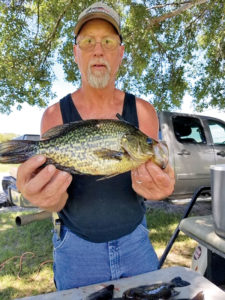
Two of the most-likely places to catch sac-a-lait consistently in March at Henderson Lake are over the mounds adjacent to and on either side of I-10, as well as the cypress-lined shore on the south end of Lake Bigeux.
One particular lure, a hair jig, in one particular color, solid black, has historically produced the most-savage reaction bite from sac-a-lait with spawning on their minds around cypress trees.
Why? Black, either a hair jig such as Mire’s D&M Custom Jig or a soft plastic tube jig, infuriates sac-a-lait during the spawn because they hate spiders.
“If you throw black in there, they’ll destroy it. Fish 6 inches deep with solid black, and they’ll come out of the water to destroy it. An old man told me that story (many years ago),” said Daniel Mire, 65, who manufacture’s D&M Custom Jigs and has caught loads of sac-a-lait shallow around cypress trees.
Black isn’t the only color that sac-a-lait bite, but it’s a dominant one, said Mire, whose other favorite March in March are black/red (another spider-themed color), black/blue, black/chartreuse and black/green.
Where to fish
Sac-a-lait gravitate to cypress trees in March, Mire said, and they also leave the deeper waters along I-10 for the mounds and flats along the concrete ribbon that crosses east to west over Henderson.
Kern’s Pit, a perennial early spring hotspot, and George Dupuis Pit are proven options, too, according Mire.
“I’ve been fishing Henderson Lake for years,” he said. “I know it like the back of my hand. It can be tough to fish, very much so. (But) I tell you what, sometimes it’s so good it’s remarkable.”
All bets are off, for the most part, if the Atchafalaya River stage at Butte La Rose is higher than 16 feet as March arrives. If the water’s that high or higher, the chances for fair to good success are few and far between, Mire said. Two of the best bets during high-water conditions would be Kern’s Pit, the levee side, and the submerged grass along the levee from Cypress Cove Landing to the bridge at Butte La Rose.

In a best-case scenario, if the BLR stage is 10 feet and falling, the sac-a-lait fishing would be “awesome,” Mire said. Heck, even a slightly higher river stage on the fall helps.
“If it stays like this (15 feet at BLR) or comes down a little bit, it’s going to be good. If it comes up like last year, in March, you’re not going to be able to catch them. They’ll be so far back in the woods you can’t get to them,” he said.
“March is very unpredictable, being the lake fluctuates by the river. If the water cleans up a little bit, the sac-a-lait usually start moving up in the shallows,” he said. When the fish get shallow, they often can be found under the hyacinths. Just scoop out a hole in the vegetation and drop in a hair jig.
Clear water is good water
Water clarity plays a key part in any success on a sac-a-lait fishing trip on the lake in March.
“If you can see your jig falling about 6 inches, that’s good. You’ll probably not catch many if you can’t see it 4 inches,” he said.
Typically, the farther west you go in the lake, the clearer the water, he said.
That’s why another area often pays off with fat and sassy slabs on his 1/32-ounce jigs fished 4 to 6 inches deep under a small cork. Mire pointed sac-a-lait fishermen to the waters over the mounds between I-10 and the private boat landings along the West Atchafalaya Basin Protection Levee.


